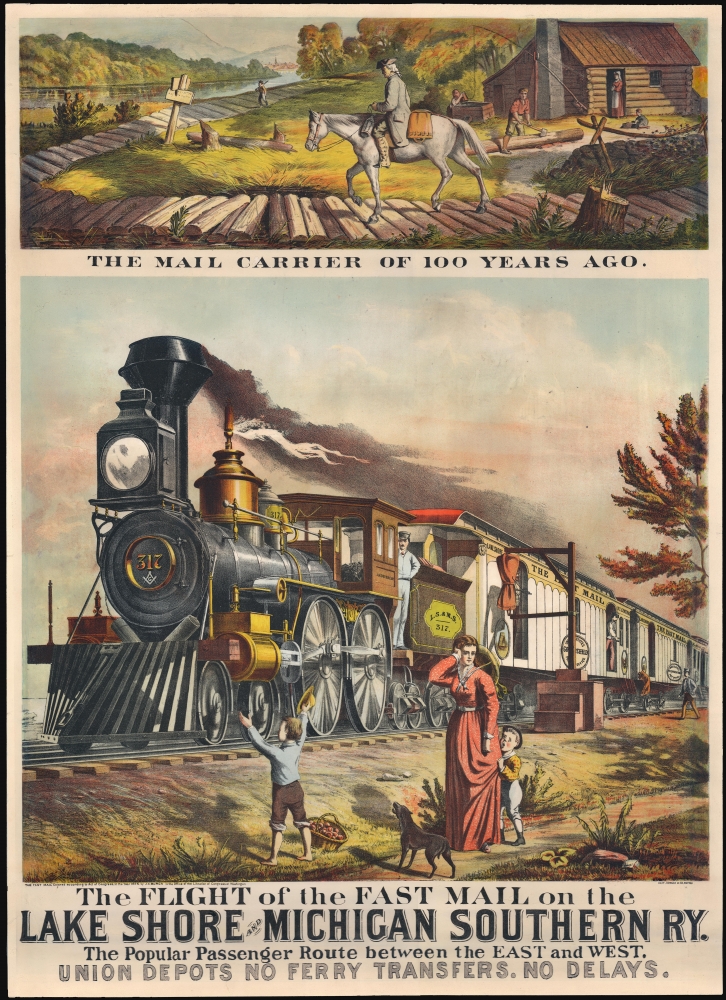Digital Image: 1875 Clay / Cosack 'Fast Mail' Railroad Broadside - First US Express Mail
FastMail-claycosack-1875_d
Title
1875 (dated) 29.5 x 21.25 in (74.93 x 53.975 cm)
Description
FOR THE ORIGINAL ANTIQUE MAP, WITH HISTORICAL ANALYSIS, CLICK HERE.
Digital Map Information
Geographicus maintains an archive of high-resolution rare map scans. We scan our maps at 300 DPI or higher, with newer images being 600 DPI, (either TIFF or JPEG, depending on when the scan was done) which is most cases in suitable for enlargement and printing.
Delivery
Once you purchase our digital scan service, you will receive a download link via email - usually within seconds. Digital orders are delivered as ZIP files, an industry standard file compression protocol that any computer should be able to unpack. Some of our files are very large, and can take some time to download. Most files are saved into your computer's 'Downloads' folder. All delivery is electronic. No physical product is shipped.
Credit and Scope of Use
You can use your digial image any way you want! Our digital images are unrestricted by copyright and can be used, modified, and published freely. The textual description that accompanies the original antique map is not included in the sale of digital images and remains protected by copyright. That said, we put significant care and effort into scanning and editing these maps, and we’d appreciate a credit when possible. Should you wish to credit us, please use the following credit line:
Courtesy of Geographicus Rare Antique Maps (https://www.geographicus.com).
How Large Can I Print?
In general, at 300 DPI, you should at least be able to double the size of the actual image, more so with our 600 DPI images. So, if the original was 10 x 12 inches, you can print at 20 x 24 inches, without quality loss. If your display requirements can accommodate some loss in image quality, you can make it even larger. That being said, no quality of scan will allow you to blow up at 10 x 12 inch map to wall size without significant quality loss. For more information, it is best consult a printer or reprographics specialist.
Refunds
If the high resolution image you ordered is unavailable, we will fully refund your purchase. Otherwise, digital images scans are a service, not a tangible product, and cannot be returned or refunded once the download link is used.
Cartographer S
Hugh De Musgrove Clay (August 27, 1834 - October 14, 1904), also known as Hugh M. Clay, was an English-American artist and chromolithographer based in Buffalo, New York. Clay arrived in the United States with his family when he was just 2. His earliest recorded work in Buffalo dates to 1854, when he was employed with the firm of Compton and Gibson. When Sage and Sons bought out Compton in 1856, they inherited Clay, who worked with them for several years. Starting in 1864, Clay partnered with Julius Herman Cosack (1826 - 1892), a fellow engraver for Sage, to found 'Clay and Cosack.' The partnership lasted until about 1877, when Clay left the firm. He subsequently partnered with Henry A. Richmond under the imprint of 'Clay and Richmond'. This firm lasted until 1886, when Clay retired and Richmond acquired the remaining stock, operating subsequently as 'Richmond Lithographing Company'. In 1896, Richmond Lithographing was bought out by Horace Reed and Hugo R. Munro, who renamed it the 'Niagara Lithograph Company', which operated well into the 20th century. Clay relocated to Manhattan, New York City in 1902, where he died in 1904. More by this mapmaker...
Julius Herman Cosack (February 15, 1826 - May 2, 1892) was a German-American engraver based in Buffalo, New York, in the second half of the 19th century. Cosack was born in Danzig, Germany, where he apprenticed as a lithographic engraver, before emigrating to the United States in 1853. He spent 3 yeas in New York before relocated to Buffalo, where he took work with the lithographic firm of Sage and Sons. There he met the English-American artist and lithographer Hugh De Musgrove Clay (1834 - 1904), with whom in 1864, he founded the lithography firm of 'Clay and Cosack.' The partnership lasted about 13 years before Clay split of, founding another firm with Henry A. Richmond. From 1878 Cosack operated independently as 'Cosack and Company' before taking on Edwin Alonso Clark (1848 - 1881) as a partner in 1880. The firm subsequently operated as 'Cosack and Clark'. Clark died suddenly in 1881, and the firm reverted again to 'Cosack and Company'. Cosack eventually took on Herman T. Koerner (1855 - 1927) and Charles Eugene Hayes (1858 - c. 1910) as partners, but did not change the imprint. The firm became prominent, acquiring a large five store building in downtown Buffalo and installing presses capable of printing 200,000 sheets a day. When Cosack died in 1892, the firm was taken over fully by Koerner and Hayes, who introduced their own imprint. Learn More...

